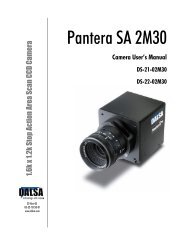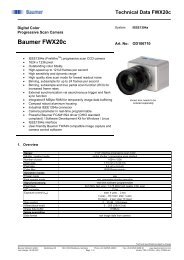Spyder 3 Camera User's Manual GigE Dual Line - Frame Grabbers
Spyder 3 Camera User's Manual GigE Dual Line - Frame Grabbers
Spyder 3 Camera User's Manual GigE Dual Line - Frame Grabbers
Create successful ePaper yourself
Turn your PDF publications into a flip-book with our unique Google optimized e-Paper software.
50<br />
<strong>Spyder</strong> 3 <strong>GigE</strong> User <strong>Manual</strong><br />
4. Click Save.<br />
To view the error report:<br />
1. Select View → Error Report.<br />
In the Open dialog box:<br />
6.2 Specific Solutions<br />
2. In the Look in list, click the drive or folder that contains the error report you want to<br />
open.<br />
3. In the folder list, locate and open the folder that contains the error report.<br />
4. Click the error report, and then click Open.<br />
No Output or Erratic Behavior<br />
If your camera provides no output or behaves erratically, it may be picking up random<br />
noise from long cables acting as antennae. Do not attach wires to unused pins. Verify that<br />
the camera is not receiving spurious inputs (e.g. EXSYNC if camera is in exposure mode<br />
that requires external signals).<br />
<strong>Line</strong> Dropout, Bright <strong>Line</strong>s, or Incorrect <strong>Line</strong> Rate<br />
Verify that the frequency of the internal sync is set correctly, or when the camera is set to<br />
external sync that the EXSYNC signal supplied to the camera does not exceed the<br />
camera’s useable <strong>Line</strong> rate under the current operating conditions.<br />
Noisy Output<br />
Check your power supply voltage outputs for noise. Noise present on these lines can<br />
result in poor video quality.<br />
Dark Patches<br />
If dark patches appear in your output the optics path may have become contaminated.<br />
Clean your lenses and sensor windows with extreme care.<br />
1. Take standard ESD precautions.<br />
2. Wear latex gloves or finger cots<br />
3. Blow off dust using a filtered blow bottle or dry, filtered compressed air.<br />
4. Fold a piece of optical lens cleaning tissue (approx. 3" x 5") to make a square pad that<br />
5. is approximately one finger-width<br />
6. Moisten the pad on one edge with 2-3 drops of clean solvent—either alcohol or<br />
acetone. Do not saturate the entire pad with solvent.<br />
7. Wipe across the length of the window in one direction with the moistened end first,<br />
followed by the rest of the pad. The dry part of the pad should follow the moistened<br />
03-032-10158-06 DALSA
















